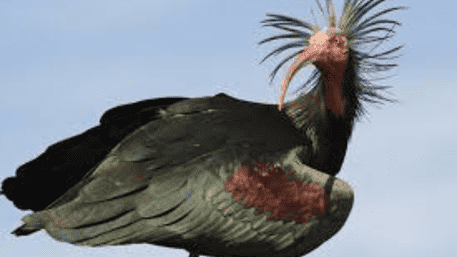The northern bald ibis, once nearly extinct by the 17th century due to overhunting, is making a remarkable return thanks to breeding and rewilding efforts over the past two decades. These unique birds, known for their striking black and iridescent green feathers, bald red heads, and long curved beaks, were once common in North Africa, the Arabian Peninsula, and parts of Europe, including southern Germany. However, without the guidance of wild-born elders, the ibises have lost their natural ability to migrate—a skill essential to their survival.
A Unique Approach to Teaching Migration
In a bid to restore the northern bald ibis population, a team of scientists and conservationists from Austria’s Waldrappteam has taken on the roles of foster parents and flight instructors for the birds. Under the leadership of conservationist Johannes Fritz, the team has successfully grown the Central European ibis population from zero to nearly 300 since the project began in 2002. Their efforts have led to the species being reclassified from “critically endangered” to “endangered”—a milestone for the conservation movement and the first reintroduction of a continentally extinct migratory bird species.
However, while the ibises still have the innate drive to migrate, they lack the knowledge of the correct routes. Early efforts to reintroduce the species into the wild were met with challenges, as the birds would often fly in the wrong direction and perish. To combat this, the Waldrappteam began acting as surrogate leaders, teaching the birds migration routes by flying alongside them in microlight aircraft.
Becoming “Bird Moms” and Flight Instructors
The rewilding process begins when the chicks are only a few days old, taken from breeding colonies and raised in an aviary. The goal is to imprint on the birds so that they see their human caretakers as parental figures. Barbara Steininger, one of the foster parents, explains her role as a “bird mom”: “We feed them, clean their nests, and make sure they are healthy. But we also interact with them closely.”
Once the birds are ready to fly, Steininger and her team take to the skies in microlight aircraft that resemble go-karts with parachutes. They guide the ibises through alpine meadows and over foothills, using bullhorns to encourage the birds to follow.
This unusual method was inspired by naturalist Bill Lishman, who famously taught Canadian geese to fly alongside his ultra-light plane in the late 1980s. His work was later adapted into the film Fly Away Home, which helped inspire Fritz’s efforts to guide the northern bald ibis back to the skies.
Successes and New Challenges
The project has seen significant success. In 2011, the first ibis successfully migrated from Tuscany to Bavaria without human assistance. Since then, many more have followed the 550-kilometer (342-mile) route, with hopes that the population will reach 350 birds by 2028 and become self-sustaining.
However, the effects of climate change have introduced new challenges. The ibises are now migrating later in the season, forcing them to cross the Alps in colder, more dangerous conditions. Without the warm air currents known as thermals to aid their journey, the birds expend more energy.
In response, the Waldrappteam piloted a new, longer migration route in 2023, guiding 36 birds from Bavaria to Andalusia, Spain, a journey that spans roughly 2,800 kilometers (1,740 miles). The trip, expected to take up to 50 days, is a testament to the team’s dedication to not only preserving the northern bald ibis but also to paving the way for other endangered migratory species.
As the birds soar across European skies, Fritz and his team hope their efforts will lead to a brighter future not just for the northern bald ibis but for other migratory species facing extinction due to human interference and climate change. This year marks the 17th human-led migration effort, and it symbolizes a monumental step in wildlife conservation and the resilience of endangered species.




















